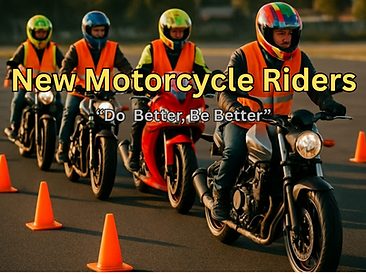The Hidden Dangers of Dehydration: Why Staying Hydrated is Essential for Every Motorcycle Rider
- NMR

- Jul 7
- 4 min read
Motorcycle riding is more than just a thrilling experience; it's a mixture of freedom, adventure, and a celebration of the open road. But with that excitement comes an important health consideration that riders often overlook: hydration. Staying hydrated is vital not only for your well-being but also for your safety while riding.
In this post, we'll dive deep into the hidden dangers of dehydration for motorcycle riders and share effective strategies to ensure you stay hydrated during your journeys.
Understanding Dehydration
Dehydration happens when your body loses more fluids than it takes in. This often occurs while riding due to sweat from heat, wind resistance, or physical exertion. For example, on a hot day, you might lose up to 1 liter of sweat per hour, which can lead to significant fluid loss.
The effects of dehydration can range from mild symptoms like fatigue and dizziness to severe risks such as heat exhaustion or heat stroke. Even a small level of dehydration, around 2% of body weight, can affect your cognitive function and reaction times, which are critical for safe riding.
The Impact of Heat on Hydration
When riding, you are exposed to the elements, and heat can significantly raise your risk for dehydration. For instance, studies show that when temperatures soar above 80°F (27°C), your body increases its sweat production. If you fail to replenish these lost fluids, your performance can drop, making you feel sluggish or faint just when you need full focus.
Long rides or navigating through heavy traffic can amplify these effects. In fact, one study found that dehydration can reduce reaction time by up to 20%. This means that staying hydrated is not just a health issue—it’s a safety issue.
Signs of Dehydration to Watch For
As a motorcycle rider, knowing the early signs of dehydration can empower you to act quickly. Here are key symptoms to watch for:
Thirst: This is often the first clue that your body is craving water. If you feel thirsty, it's time to drink.
Dry Mouth: A dry or sticky sensation in your mouth can be a clear sign that hydration is needed.
Fatigue: If you’re feeling less energetic during your ride, it could indicate dehydration.
Dizziness: Feeling lightheaded can affect your balance and coordination, both essential for safe riding.
Dark Urine: If your urine appears dark yellow or amber, it often signals that you’re not drinking enough fluids.
Being aware of these signs can help you take proactive steps to avoid serious dehydration.
Why Hydration Matters for Safety
Your focus and reaction time are vital for safe riding. Dehydration can cloud your thinking and slow your motor skills, which can have serious consequences on the road. Picture this: while leaning into a tight corner, mild dehydration could make you react slower than usual. You might miss braking in time, putting your safety at risk.
Conversely, staying hydrated helps you remain alert and quick on your feet, ensuring that you can respond effectively to challenges that come your way.
Practical Tips for Staying Hydrated
Understanding the importance of hydration is the first step; here are practical tips to ensure you stay hydrated on your rides:
1. Invest in a Hydration Pack
A hydration pack lets you sip water without stopping. It’s designed for comfort and can hold enough fluid for long rides, ensuring you have easy access to hydration throughout your journey.
2. Schedule Regular Breaks
Plan your trips with intervals to hydrate. Taking just a few minutes to drink water can help replenish lost fluids and give your body a chance to recharge.
3. Drink Water Before You Ride
Pre-hydrating sets you up for success. Aim to drink at least 500 milliliters of water in the hour before your ride. Consider adding electrolyte drinks or including hydrating fruits like watermelon or oranges in your pre-ride snacks.
4. Avoid Caffeinated Beverages
While coffee and energy drinks might give a quick boost, they can also lead to dehydration. For rides longer than an hour, opt for water or electrolyte drinks instead.
5. Monitor Weather Conditions
Keep an eye on the temperature and humidity. On hot days, you should increase your fluid intake even if you don’t feel thirsty.
6. Keep Hydration Essentials on Hand
Always bring a water bottle or hydration pack. The easier it is to access water, the more likely you are to drink regularly.
Embracing the Adventure Responsibly
Motorcycle riding is a passion that builds community among riders. Yet, prioritizing your health is crucial for fully enjoying this lifestyle. Hydration is a key element that should not be overlooked. By staying hydrated, you not only improve your riding experience but also protect yourself from the dangers of dehydration.

Awareness of dehydration's hidden dangers is critical for motorcycle riders. Neglecting your fluid intake can negatively impact your ride, health, and safety. Make hydration a priority to enjoy every journey at your best. When you gear up for your next adventure, remember: ride safely, stay hydrated, and savor each moment on the road.






.png)



Comments